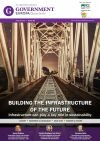
New research has shown that a growing number of UK residents are in favour of more stringent measures to protect vulnerable road users.
The study, conducted by security barrier innovation firm ATG Access, examines the growing issues attached to urbanisation in the UK and the resulting increased risk to vulnerable road users, comprising pedestrians, cyclists and other non-drivers. It found that 66% of UK respondents are in favour of increased smart city technology solutions in their area aimed at improving the security and safety of pedestrians; while 56% of respondents advocated further smart city measures focused on protecting cyclists.
ATG Access Managing Director Gavin Hepburn said: “While cyclist and pedestrian safety is undoubtedly a key concern for planning and transport departments, the most recent government data shows that 18,477 cyclists were injured in reported road accidents in 2016, including 3,499 who were killed or seriously injured. This clearly shows that we are currently struggling to find effective ways of making the roads safe for cyclists, and must start exploring new, more sophisticated methods of improving our transport infrastructure. This will only become more important as our cities are expected to become increasingly congested in the coming years.”
40% of the study’s respondents supported the implementation of smart barriers – which can extend and retract based on real time traffic density data – to enforce dedicated cycle and bus lanes to ensure the safety of vulnerable road users during periods of high traffic. 47%, meanwhile, were in favour of the strategic deployment of smart road sensors, which monitor in real time events likely to effect traffic – including road accidents, weather events and other hazards – in order to streamline the flow of traffic and protect the safety of road users.
Hepburn added: “The strategic implementation of smart city measures could help to greatly increase the safety of cyclists, pedestrians and drivers, while also making it more appealing for greater numbers of people to walk or cycle, which will be crucial if we are to achieve a more sustainable future.”


















